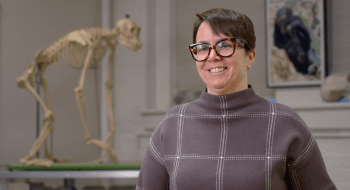
Preparing for a Life in Service
Garnet Williams ’19, a history and geology double major with an African studies minor, explains that he has always been interested in history; however, geology came as a surprise.
It happened in fall 2016, when Williams took Intro to Geology with Alexander K. Stewart, associate professor and chair of the Department of Geology, and was one of only two first-year students to be accepted on an upper-division travel course studying glacial geology in Iceland. Tackling two majors and a minor can be overwhelming to many; but for Williams, academics was only part of the rigor of his undergraduate years. As a Reserve Officers' Training Corps (ROTC) cadet, Williams had to navigate both the physical and mental rigors of the training program while sustaining his academic workload.
“Garnet combined his double major and minor, along with ROTC very well,” Stewart says. As Williams’s advisor, Stewart has a unique perspective on how studying geology and military careers can complement each other. Retired from the U.S. Army, Stewart is a veteran of the Cold War and three foreign wars with 20-plus years of military experience. His service in the Army included time in Alaska, which inspired him to pursue a Ph.D. in glacial geology and geomorphology.
Each summer, Williams has filled his time with essential trainings and different experiences, including air assault school for helicopters and rappelling as well as going to Nepal for a month with the Army. In summer 2018, he had his final senior training exercises at the United States Army post in Fort Knox, Kentucky, and attended an Army Cadet Troop Leader Training in El Paso, Texas, where he shadowed a lieutenant for three weeks.
“While Garnet was finishing up his senior summer training,” Stewart says, “we communicated as much as we could to discuss how the skills he’s learning as a geologist and observational scientist has helped him as a ROTC cadet in field environments.”
Williams, originally from Barneveld, New York, was accepted to St. Lawrence by going through the ROTC program, which runs for the entirety of a student’s time on campus and can create a demanding weekly schedule. On top of mandatory training commitments, each St. Lawrence cadet commutes to Clarkson University in Potsdam, New York, for every requirement.
While just completing the four-year program is an accomplishment, Williams managed to excel, and his cadre took notice. The instructors selected him as the top cadet out of all four Associated Colleges of St. Lawrence Valley consortium of North Country colleges and universities and sent him as the group’s representative to the George C. Marshall Leadership Seminar in Fort Leavenworth, Kansas.
“It was an eye-opening experience overall,” says Williams about the conference. “They kept stressing to all the cadets that we are no longer college students once we graduate. We are going to be leaders and are going to have 40 people looking at us for answers. I will be responsible for them as well as the success and failure of everyone under me.”
Stewart believes that Williams is ready for this next step. “His personality is quiet and relaxed, and I think that allows him to focus and concentrate without being distracted by other things,” says Stewart. “He has a good sense of keeping his cards close. He doesn’t feel required or a necessity to impress people.”
Williams’ plans after graduation include serving four years of active duty and four years of individual reserve as a field artillery officer, which requires him to be prepared for active duty at any time. However, Stewart is confident that, like the many facets of Williams’ undergraduate career at St. Lawrence, his future will have many layers and opportunities.
“He wants to serve his country as much as he can,” says Stewart. “But, I want to make sure he comes out in four to eight years moving forward and still doing what he is passionate about. Whatever he does in life, he will be successful; we are just hoping that he doesn’t forget about the geology department!”
Garnet Williams graduated as a member of both Sigma Gamma Epsilon, the geology honors society, and Phi Alpha Theta, the history honors society.




